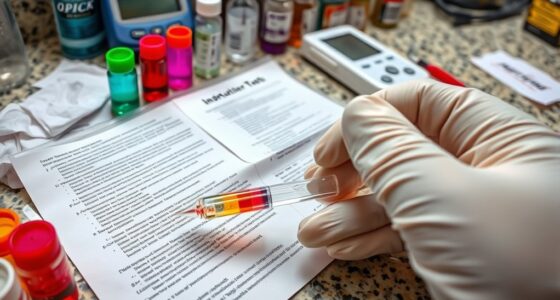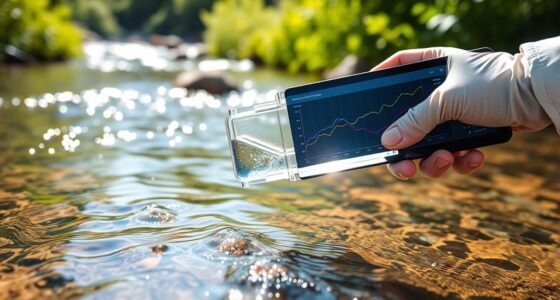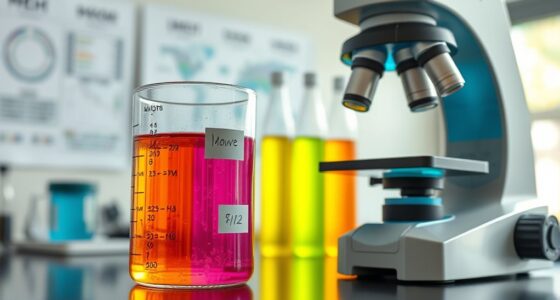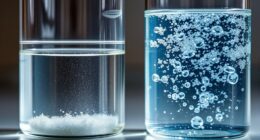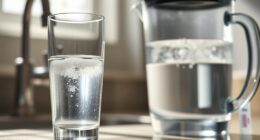If your chlorine residual test results seem inconsistent, start by checking your sample collection—make sure containers are clean and sample water is stored properly. Verify that your testing equipment is calibrated and functioning correctly, and watch out for chemical or biological interferences like iron or algae that can distort results. Proper technique and equipment maintenance are key. To clear up common issues and improve accuracy, keep exploring more tips and guidance.
Key Takeaways
- Ensure proper sample collection by using clean, sterile bottles and storing samples in cool, shaded areas before testing.
- Regularly calibrate and verify testing equipment with standard solutions to maintain accuracy.
- Recognize and address chemical interferences like iron or manganese that can skew test results.
- Monitor environmental factors such as temperature and sunlight, which can cause fluctuations in chlorine residuals.
- Follow manufacturer instructions carefully for test procedures and replace expired reagents promptly for reliable results.
Understanding Chlorine Residuals and Why They Matter

Understanding chlorine residuals is essential because they indicate whether your water treatment is effective at disinfecting. Chlorine stability refers to how well chlorine remains active in your water over time, preventing bacterial growth. Residual monitoring involves regularly testing the chlorine levels to ensure they stay within the safe and effective range. If residuals drop too low, your water might not be adequately disinfected; if they’re too high, it could cause taste issues or harm. By keeping a close eye on residuals, you can adjust your treatment process to maintain proper chlorine stability and ensure continuous, reliable disinfection. Regular testing helps you identify fluctuations early, so you can keep your water safe and compliant with standards. Additionally, tuning your water treatment system can optimize chlorine performance and improve overall water quality.
Common Causes of Inconsistent Test Results

Inconsistent test results can often be traced back to factors that interfere with accurate chlorine residual measurement. One common cause is poor chlorine stability, which occurs when chlorine levels fluctuate due to temperature changes or exposure to sunlight. If you don’t regularly check chlorine stability, your readings may be unreliable. Another frequent issue is improper reagent storage; reagents should be kept in cool, dark places to prevent degradation. If reagents are expired or exposed to air, their effectiveness drops, leading to inaccurate results. Additionally, inconsistent testing procedures, such as using different test kits or not following instructions precisely, can cause variations. Ensuring proper reagent storage and monitoring chlorine stability are vital steps to improve consistency and reliability in your chlorine residual testing. Incorporating automation’s role in business intelligence can also help streamline data collection and reduce human error, further enhancing test accuracy.
Proper Sample Collection Techniques

To guarantee accurate chlorine residual testing, proper sample collection techniques are essential. Begin by thoroughly cleaning your sampling container to prevent contamination. Use sterile or approved bottles designed for water testing, and avoid touching the inside of the cap or container. When collecting the sample, ensure you submerge the bottle below the water surface without disturbing the sediment or surface film, which can skew results. Fill the container to the designated level, leaving minimal air space to prevent oxygen exposure that could alter chlorine levels. Immediately cap the sample securely and store it in a cool, shaded place until testing. Following these steps helps prevent contamination and preserves the sample’s integrity, assuring reliable chlorine residual measurements. Additionally, understanding the influence of sample handling on test accuracy is crucial for consistent results.
Choosing the Right Testing Method for Your Needs

When selecting a testing method, you should consider the different test types available and how they match your accuracy and precision requirements. Cost and ease of use also play a big role in choosing the best option for your situation. By weighing these points, you can find a method that fits your needs and guarantees reliable chlorine residual measurements. Understanding test validity helps ensure that the results you obtain are trustworthy and meaningful.
Test Type Options
Choosing the right chlorine residual testing method depends on your specific needs and the resources available. You can compare test kits to find one that suits your budget and accuracy requirements through a test kit comparison. Traditional colorimetric test kits are affordable and simple to use, but they may require more time and manual interpretation. Digital testing options, on the other hand, provide quick, precise readings with minimal user error, making them ideal for frequent testing. Consider your testing environment and the level of accuracy you need when selecting between these options. If you need quick results with less hassle, digital testers might be best. However, if cost is a concern and you’re okay with manual interpretation, test kits are a practical choice. Additionally, understanding the signs of spoilage in lemon juice can help ensure the safety of your water testing procedures.
Accuracy and Precision
Selecting the appropriate chlorine residual testing method hinges on understanding how accuracy and precision impact your results. In chlorine chemistry, accurate tests reflect the true chlorine levels, helping you maintain safe water quality. Precision ensures the results are consistent across multiple tests, reducing variability. Water pH influences test accuracy because it affects chlorine chemistry, altering how reagents react. A test that’s both accurate and precise allows you to make informed decisions about chlorination levels. For example, colorimetric methods may offer good precision but can be affected by pH shifts, while titration methods often provide higher accuracy if performed correctly. Choosing a method that balances these factors guarantees reliable monitoring, ultimately helping you maintain effective disinfection and water safety. Additionally, understanding total‑cost clarity and system comparison guides can help you select the most suitable testing approach for your specific water quality needs.
Cost and Ease
Cost and ease are often the deciding factors when determining which chlorine residual testing method to use, especially for routine monitoring. A thorough cost analysis helps you compare expenses like initial equipment, consumables, and maintenance. Simpler methods, such as test strips, typically cost less and are easier to utilize, making them ideal for frequent testing or fieldwork. On the other hand, more advanced techniques, like colorimeters or laboratory tests, may require higher upfront investment but provide greater accuracy. Consider your staff’s training level and testing frequency when evaluating ease of use. Additionally, understanding the testing method’s reliability is crucial to ensure consistent water quality results. Ultimately, choosing a method that balances affordability with simplicity ensures reliable results without unnecessary complexity, saving you time and resources while maintaining water quality.
Interpreting Test Results Accurately

Are you confident you’re interpreting chlorine residual test results correctly? Accurate interpretation guarantees proper chlorine stability and effective disinfection. First, compare your residual measurement to the target range set by regulations or your water system’s standards. A residual that’s too low indicates insufficient chlorine, risking pathogen survival, while a high residual might suggest over-chlorination, which can cause taste issues. Remember, fluctuations in residual levels can occur due to factors like temperature or demand changes. Always consider the context of your test results, and avoid jumping to conclusions based on a single measurement. Regularly reviewing trends over time helps you better understand your water’s chlorine stability. This approach ensures your residual levels remain effective without compromising water quality or safety. Incorporating proper backup systems such as generators or portable power stations can help maintain water treatment operations during outages, ensuring consistent disinfection.
Troubleshooting Equipment and Test Kits

To make certain your chlorine testing remains accurate, you need to regularly check calibration and accuracy of your equipment. Proper storage of test kits helps maintain their reliability, while routine maintenance prevents malfunctions. Addressing these key points keeps your testing equipment functioning correctly and provides trustworthy results.
Calibration and Accuracy Checks
Ensuring your chlorine residual testing equipment and test kits provide accurate results requires regular calibration and accuracy checks. Start by following proper calibration procedures, which often involve using standard solutions with known chlorine levels. This helps guarantee your device reads correctly across the measurement range. Conduct accuracy verification periodically by comparing your test results with these standards. If discrepancies appear, recalibrate the equipment or replace the test kit if it’s expired or damaged. Consistent calibration and verification help prevent false readings, which can lead to unsafe water conditions or regulatory violations. Keep a log of calibration dates and results to track performance over time. Regularly performing these checks maintains confidence in your testing process and ensures reliable, precise chlorine residual measurements. Additionally, understanding the performance features of your testing equipment can aid in troubleshooting and maintaining accuracy.
Proper Test Kit Storage
Proper storage of your test kits is vital for maintaining their accuracy and reliability over time. Correct test kit storage prevents deterioration of reagents and guarantees consistent results. Keep test kits in a cool, dry place away from direct sunlight, heat, and humidity, which can degrade the chemicals. Store reagents in tightly sealed containers, following the manufacturer’s instructions, to prevent contamination and evaporation. Avoid exposure to air and moisture, as these can affect test accuracy. Label storage areas clearly and keep test kits organized to prevent mix-ups. Check expiration dates regularly and replace expired reagents promptly. Proper storage also helps preserve the integrity of the chemicals needed for inspirational quotes about fatherhood, ensuring that your chlorine residual tests remain precise and dependable, saving you time and avoiding costly errors.
Regular Maintenance Procedures
Regular maintenance is essential to keep your chlorine residual testing equipment functioning accurately and reliably. You should regularly clean test kits and equipment to prevent buildup that can interfere with chemical reactions, leading to inaccurate readings. Check for signs of wear or damage, replacing parts as needed. Calibration is also crucial to maintain precision, especially after any testing anomalies. Always follow safety precautions, such as wearing gloves and eye protection, because reagents can be hazardous. Proper storage of chemicals and test kits prevents contamination and degradation, ensuring consistent results. Routine maintenance reduces troubleshooting time and enhances safety. By staying diligent with these procedures, you ensure accurate chlorine residual testing and protect yourself from potential chemical hazards.
Dealing With Interferences and Contaminants

Interferences and contaminants can considerably affect chlorine residual testing, leading to inaccurate results if not properly addressed. Chemical contaminants like iron, manganese, or hydrogen sulfide can interfere with test reagents, causing false readings or masking the actual chlorine levels. Biological interference, such as algae or bacteria, can also skew results by consuming chlorine or producing byproducts that react with testing chemicals. To minimize these issues, ensure your samples are collected properly, avoiding contamination from external sources. Use clean bottles and handle samples carefully. If you suspect chemical contaminants, consider pretreatment methods like filtration or adding reagents to neutralize interference. Regularly reviewing your testing procedures helps you identify and correct potential sources of interference, ensuring more reliable chlorine residual measurements.
Maintaining and Calibrating Testing Instruments

Accurate chlorine residual testing depends heavily on well-maintained and properly calibrated instruments. Regular instrument calibration ensures your readings stay precise, so you can trust the results. Follow the manufacturer’s instructions for calibration procedures, and do this frequently, especially if your readings seem inconsistent. Proper reagent storage is equally important—store reagents in a cool, dry place, and check expiration dates regularly. Using expired or improperly stored reagents can lead to inaccurate results. Keep calibration solutions fresh and handle all testing materials carefully to avoid contamination. By maintaining your testing instruments and storing reagents correctly, you reduce errors and improve reliability, making your chlorine residual assessments more consistent and trustworthy.
Best Practices for Reliable Chlorine Testing

To guarantee your chlorine testing results are dependable, adopting best practices is essential. First, test samples promptly to minimize chlorine decay, which can cause inaccurate readings over time. Ensure samples are stored in dark, cool conditions if testing is delayed. Always check the pH influence on your test method, as high or low pH levels can skew results, making chlorine appear higher or lower than it truly is. Use properly calibrated instruments and fresh reagents to maintain accuracy. Regularly clean test equipment to prevent contamination. Record test conditions, including pH and sample age, to identify patterns or inconsistencies. By following these practices, you’ll improve test reliability, accurately monitor chlorine residuals, and effectively manage water quality.
Frequently Asked Questions
How Often Should I Perform Chlorine Residual Testing?
You should perform chlorine residual testing daily to guarantee chlorine stability and effective disinfection. Testing frequency depends on your water system’s size, usage, and regulations, but daily checks help catch any drops in chlorine levels early. Regular testing ensures your water remains safe, and adjustments can be made promptly. For high-risk or fluctuating systems, consider testing multiple times a day to maintain ideal chlorine residuals.
Can Temperature Affect Chlorine Residual Test Results?
Just like a knight’s armor, temperature influences chlorine residual test accuracy. When it’s too hot or cold, the temperature influence can cause your test results to be off. High temperatures may cause chlorine to degrade faster, leading to lower residual readings, while cold temperatures can slow chemical reactions, skewing results. Always perform tests at consistent temperatures or account for temperature variations to guarantee accurate readings and reliable water quality data.
What Safety Precautions Are Recommended During Testing?
During testing, you should wear personal protective equipment like gloves and goggles to prevent chemical exposure. Make certain proper ventilation in the workspace to avoid inhaling chlorine fumes. Handle chlorine samples carefully, following safety guidelines, and avoid spills or splashes. Always wash your hands thoroughly afterward, and keep emergency eyewash stations nearby. These precautions help protect you from potential health risks associated with chlorine testing.
How Do I Detect if My Test Kit Is Expired?
You can detect if your test kit is expired by checking the reagent shelf life printed on the packaging. If the expiration date has passed, the chemicals may not react properly, giving inaccurate results. Also, look for any color changes or deterioration in the reagents, which indicate they’re no longer dependable. Always store your test kit properly and replace it before the expiration date to ensure accurate chlorine residual testing.
What Steps Should I Take if Test Results Are Inconsistent?
If your test results are inconsistent, first check for sample contamination by ensuring your sample isn’t exposed to foreign substances. Next, verify reagent stability—expired or improperly stored reagents can cause inaccuracies. Use fresh reagents and clean testing equipment thoroughly. Re-test your sample carefully, following the proper procedure. If results still vary, consider calibrating your test kit or replacing it altogether to maintain accuracy.
Conclusion
Now that you understand how to troubleshoot chlorine residual testing, you can confidently guarantee safe water. While equipment and technique matter, your attention to detail makes all the difference. Think of testing as both a science and an art—you need precision and patience. By mastering these skills, you’ll prevent unsafe surprises and enjoy peace of mind. Because in water safety, accuracy isn’t just a goal; it’s your responsibility.



